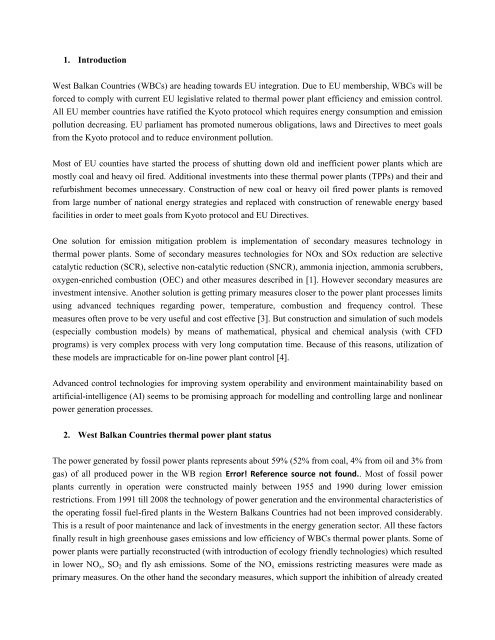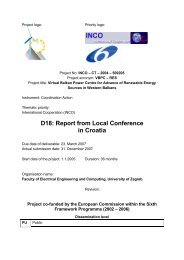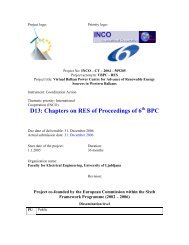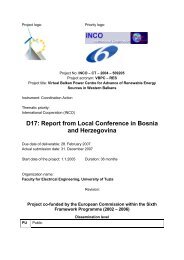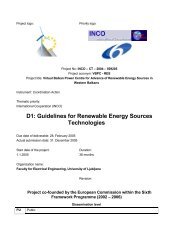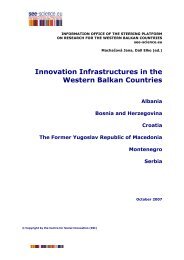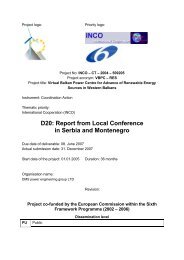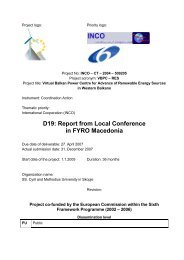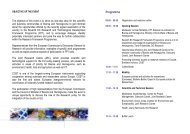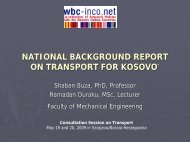Improvement of Environmental Aspects of Thermal Power Plant ...
Improvement of Environmental Aspects of Thermal Power Plant ...
Improvement of Environmental Aspects of Thermal Power Plant ...
Create successful ePaper yourself
Turn your PDF publications into a flip-book with our unique Google optimized e-Paper software.
1. Introduction<br />
West Balkan Countries (WBCs) are heading towards EU integration. Due to EU membership, WBCs will be<br />
forced to comply with current EU legislative related to thermal power plant efficiency and emission control.<br />
All EU member countries have ratified the Kyoto protocol which requires energy consumption and emission<br />
pollution decreasing. EU parliament has promoted numerous obligations, laws and Directives to meet goals<br />
from the Kyoto protocol and to reduce environment pollution.<br />
Most <strong>of</strong> EU counties have started the process <strong>of</strong> shutting down old and inefficient power plants which are<br />
mostly coal and heavy oil fired. Additional investments into these thermal power plants (TPPs) and their and<br />
refurbishment becomes unnecessary. Construction <strong>of</strong> new coal or heavy oil fired power plants is removed<br />
from large number <strong>of</strong> national energy strategies and replaced with construction <strong>of</strong> renewable energy based<br />
facilities in order to meet goals from Kyoto protocol and EU Directives.<br />
One solution for emission mitigation problem is implementation <strong>of</strong> secondary measures technology in<br />
thermal power plants. Some <strong>of</strong> secondary measures technologies for NOx and SOx reduction are selective<br />
catalytic reduction (SCR), selective non-catalytic reduction (SNCR), ammonia injection, ammonia scrubbers,<br />
oxygen-enriched combustion (OEC) and other measures described in [1]. However secondary measures are<br />
investment intensive. Another solution is getting primary measures closer to the power plant processes limits<br />
using advanced techniques regarding power, temperature, combustion and frequency control. These<br />
measures <strong>of</strong>ten prove to be very useful and cost effective [3]. But construction and simulation <strong>of</strong> such models<br />
(especially combustion models) by means <strong>of</strong> mathematical, physical and chemical analysis (with CFD<br />
programs) is very complex process with very long computation time. Because <strong>of</strong> this reasons, utilization <strong>of</strong><br />
these models are impracticable for on-line power plant control [4].<br />
Advanced control technologies for improving system operability and environment maintainability based on<br />
artificial-intelligence (AI) seems to be promising approach for modelling and controlling large and nonlinear<br />
power generation processes.<br />
2. West Balkan Countries thermal power plant status<br />
The power generated by fossil power plants represents about 59% (52% from coal, 4% from oil and 3% from<br />
gas) <strong>of</strong> all produced power in the WB region Error! Reference source not found.. Most <strong>of</strong> fossil power<br />
plants currently in operation were constructed mainly between 1955 and 1990 during lower emission<br />
restrictions. From 1991 till 2008 the technology <strong>of</strong> power generation and the environmental characteristics <strong>of</strong><br />
the operating fossil fuel-fired plants in the Western Balkans Countries had not been improved considerably.<br />
This is a result <strong>of</strong> poor maintenance and lack <strong>of</strong> investments in the energy generation sector. All these factors<br />
finally result in high greenhouse gases emissions and low efficiency <strong>of</strong> WBCs thermal power plants. Some <strong>of</strong><br />
power plants were partially reconstructed (with introduction <strong>of</strong> ecology friendly technologies) which resulted<br />
in lower NOx, SO2 and fly ash emissions. Some <strong>of</strong> the NOx emissions restricting measures were made as<br />
primary measures. On the other hand the secondary measures, which support the inhibition <strong>of</strong> already created


